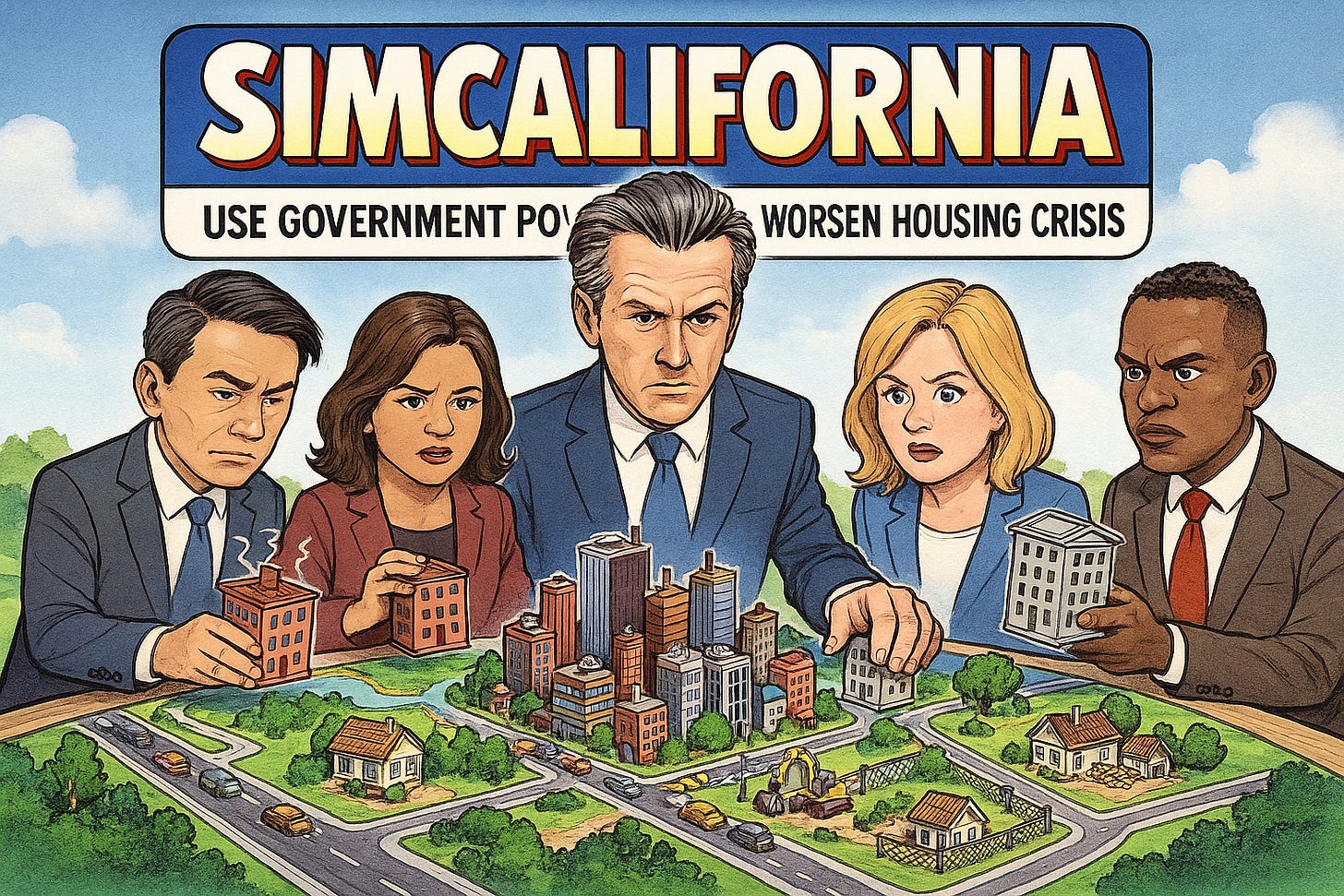California’s Housing Debacle: When Newsom’s “Solutions” Build Walls, Not Homes
State Overreach Turns Dream Homes into Nightmares, with Median Prices Approaching $900,000 and Construction Costs Inflated Around 30% from Fees Alone
⏱️ 4.5 min read
A Regulatory Nightmare Strangles Supply
California’s housing crisis isn’t a mystery—it’s a manufactured disaster, created by decades of state meddling and overreach. Governors from Jerry Brown to Gavin Newsom and a legislature hostile to deregulation have piled on rules that choke the supply. Over 100 bills since 2017 promised more homes, yet housing starts remain well below demand, leaving a shortage of 2 to 3 million units.
The California Environmental Quality Act (CEQA), once a shield for nature, now fuels lawsuits that stall projects for years, often adding delay and driving costs up by 20–30%. One San Francisco project took six years and over a million dollars in compliance, including tens of thousands for historical reviews. Add hidden fees that feel like extortion—such as tens of thousands in “traffic mitigation” charges for single homes or infrastructure fees that never materialize. That’s not policy — that’s a shakedown.
Fees and Mandates Crush Affordability
Newsom’s “affordable housing” laws are a case study in how centralized planning backfires. Mandates requiring 15–20% low-income units sound noble, but can raise costs on market-rate homes by hundreds of dollars per square foot. AB 130, signed this year, adds a new Vehicle Miles Traveled (VMT) framework, letting agencies charge developers to offset projected driving by funding transit or housing elsewhere. This is a new housing tax families cannot afford.” Developers just pass the costs along to potential buyers.
Environmental and mitigation rules enable open-ended fees that discourage building rather than encourage it. Prevailing wage mandates, often adding 10–20% to labor costs, make “streamlining” meaningless. At the Capitol, powerful trade unions wield enormous clout, demanding concessions for even modest reforms, guaranteeing higher costs and fewer homes.
Socialistic Embrace of High-Density Housing Makes Things Worse
The legislature’s obsession with high-density urban infill is a rigid, top-down fantasy. These liberals in the legislature cannot handle the idea of people with free agency deciding how they want to live and making choices. They obsess on passing policies that force their agenda on the people of California, like they are playing a game of “SimCalifornia.”
Sen. Scott Wiener’s SB 79, for instance, overrides local zoning to force high-rises near bus stops, even in single-family areas. Mandating 10–30 units per acre inflates land costs, favors big developers, and ignores families who want a yard, not a shoebox.
Remote work has cut commuting, yet Sacramento clings to transit-hub density. And when wildfire risks threatened wealthy enclaves, Newsom suspended mandates like SB 9—exempting gentry liberals (donors?) from the policies he forces on everyone else.
Local Fumbles Amplify State Failures
If Sacramento sets the stage, cities like Los Angeles finish the debacle. A Los Angeles Times story yesterday describes how regulations and policy whiplash are driving out investors essential for new apartments. Approvals have fallen sharply in recent years, even as demand grows. Add Measure ULA’s transfer tax and lingering eviction rules, and what should be a boom has become a landscape of stalled projects.
Oakland and San Francisco echo the mess. CEQA lawsuits stall even farmworker housing. Post-2025 exemptions still come tied to labor mandates that raise costs. San Francisco’s outdated zoning and crushing impact fees—sometimes $50,000 per unit—are throttling supply, leaving tens of thousands of units stuck in limbo.
Trade Union Influence Makes Everything Worse
Unions play a central role in driving costs, using their clout to saddle builders with added expenses. In Los Angeles County, they’re pushing for a $25-an-hour minimum wage—the nation’s highest—on top of prevailing wage mandates and project labor agreements that already inflate costs 15–20%. Across the Bay Area, similar rules choke off smaller developers and stall modest projects, ensuring only the deepest-pocketed players can compete.
Local governments repeat the state’s mistakes: treating builders as cash machines, not partners. The result? Tent cities grow faster than housing.
So, Does It Matter?
This crisis matters because it undermines California’s promise—that hard work buys a home, a yard, a future. With median prices near $900,000 and six-figure fees on top, young families bolt for Texas. Small businesses close, unable to hire workers who can’t afford rent. Innovation slows as California chokes on its own rules.
The Hoover Institution points to the solution: slash regulations to unleash market-led growth. A free market lets a bigger house free up a smaller one, a condo, or an apartment—each move opens a door for someone else. Newsom’s meddling breaks that ladder.
If we don’t dismantle this regulatory maze, California risks becoming a land of vacant lots and broken dreams. Deregulate, untax, and let builders build. Anything less is just more walls where homes should stand. And a worsening shortfall of housing.
Our morning columns are free to all subscribers. But I try to add something extra for our paid subscribers. Under the paywall you will find three alternative cartoon images that I created for this column that ultimately I did not use (in favor of the SimCalifornia image above). Enjoy. Of course, if you aren’t a paid subscriber yet - you don’t need FOMO. Read about what you get here.
Keep reading with a 7-day free trial
Subscribe to So, Does It Matter? California Politics! to keep reading this post and get 7 days of free access to the full post archives.



